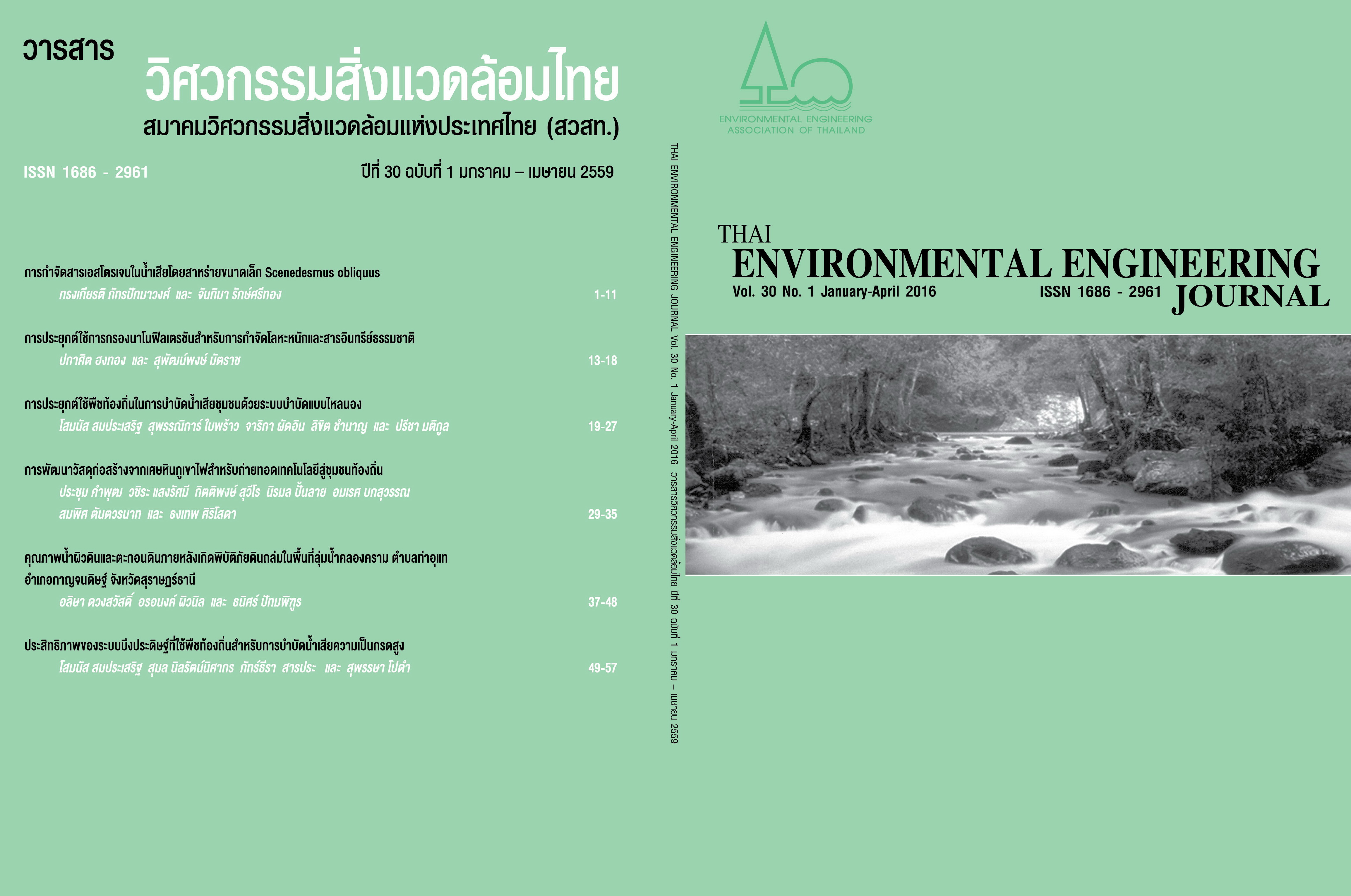Surface Water and Sediment Quality after Landslide Hazards In Khlong Kram Watershed Areas at Tah Utae Sub-District, Kanchanadit District, Surat Thani Province
Main Article Content
Abstract
Landslide disaster occurred in Suratthani province in 2011 which public water consumption in Klong Kram watershed was effected from eroded soil sediment. This study was conducted to investigate surface water and soil sediment quality after landslide hazards in the watershed. The samples were collected 9 stations of surface water and soil sediment and collected during wet period (December 2014) and dry period (April 2015). The water samples were determined which according to standard guidelines of surface water quality. The results showed that sampling station SW8 was detected 2.3 mg/l of BOD concentration. The total coliform bacteria, E. coli and fecal coliform bacteria were detected in every sampling station. The sampling station SW4 was detected 9,200 MPN/100 ml. of total coliform bacteria, 140 CFU/ml. of E. coli, and 1,400 MPN/100 ml. of fecal coliform bacteria, respectively, in wet period. The surface water and sediment samples were detected heavy metals in every sampling station. Especially sampling station SW2, arsenic concentration in water sample was detected 0.0201 mg/L in dry season, while as arsenic in soil sediments were detected 132.42 mg/kg in wet period and 102.89 mg/kg in dry period, respectively. Arsenic concentration in this station was higher than the others due to sediments were eroded from landslide hazards near the stream. The geological characteristics of this area was granite, therefore, the accumulated arsenic concentration was exceed than the limits of surface water quality standards. The results might be concluded that surface water quality and soil sediment in the watershed were affected from landslide hazards and the potentials of stream was not suitable for directly consumption but might be used for agriculture.
Article Details
References
[2] U.S. EPA. 1999. Standard Operating Procedure for the Digestion of Solid Samples Using Method 3050B.U.S. Environmental Protection Agency, Washington, DC.
[3] Lohkam, P. 1999. Effect of land use and land cover changes to physical water qualities in streamflow of representative watersheds: Case study at Maetaeng, Choen and Klongyan watersheds. Master’s Thesis, Kasetsart University. (in Thai)
[4] Tippmasn, N. and S. Pukngam. 2009. Water quality monitoring in forested, agricultural and mixed forested agricultural areas using small watersheds in the Mae Thang sub-watershed, Phrae province. Thai Journal of Forestry 28(1): 51-66. (in Thai)
[5] Palma, P., L. Ledo, S. Soares, I.R. Barbosa, and P. Alvarenga. 2013. Spatial and temporal variability of the water and sediments quality in the Alqueva reservoir (Guadiana Basin; southern Portugal). Sci. Total Environ. 470: 780-790.
[6] Kibena, J., I. Nhapi, and W. Gumindoga. 2013. Assessing the relationship between water quality parameters and change in land use patterns in the Upper Manyame River, Zimbabwe. Phys. Chem. Earth. 67: 153-163.
[7] Notification of the National Environmental Board, No. 8, B.E. 2537 (1994), issued under the Enhancement and Conservation of National Environmental Quality Act B.E.2535 (1992), published in the Royal Government Gazette, Vol. 111, Part 16, dated February 24, B.E.2537 (1994).
[8] Hong, H., J. Qiu, and Y. Liang. 2009. Environmental factors influencing the distribution of total and fecal coliform bacteria in six water storage reservoirs in the Pearl River Delta Region, China. J. Environ. Sci. 22(5): 663-668.
[9] Pollution Control Department. 2004. Soil quality standards for residential and agricultural use. Source: http://www.pcd.go.th, 11 July 2014.


